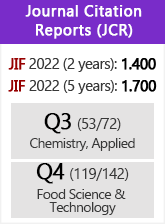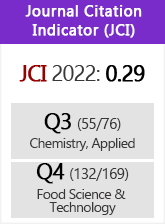A survey of phthalates in flavored olive oils from Turkey
DOI:
https://doi.org/10.3989/gya.1235212Keywords:
Contaminants, Diethylhexyl phthalate (DEHP), Flavored olive oil, Phthalates, TurkeyAbstract
Phthalates are organic contaminants that are used as plasticizers in many plastic food packaging materials. Because of their lipophilic character, oils are the primary source of human exposure to phthalates. In this study, the presence of five phthalate esters; diethylhexyl phthalate (DEHP), dibutyl phthalate (DBP), butyl benzyl phthalate (BBP), diisononyl phthalate (DINP) and diisodecyl phthalate (DIDP) in olive oils flavored with different materials and marketed in Turkey in 2020 was determined. The samples included BBP, DINP, DIDP at lower concentrations than their LOQ. DEHP was the most abundant phthalate in all samples at varying concentrations between < LOQ to 1.81 mg/kg. The highest amount of DEHP was found in the oil sample flavored with bergamot (1.81 mg/kg). DBP was detected in 9 of the 25 samples at concentrations from 0.11 to 0.27 mg/kg.
Downloads
References
Ayadi MA, Grati-Kamoun N, Attia H. 2009. Physico-chemical change and heat stability of extra virgin olive oils flavoured by selected Tunisian aromatic plants. Food Chem. Toxicol. 47, 2613-2619. https://doi.org/10.1016/j.fct.2009.07.024 PMid:19635520
Baiano A, Gambacorta G, La Notte E. 2010. Aromatization of olive oil. Transworld Research Network 661, 1-29.
Barbagallo I, Volti GL, Raffaele M, Distefano A, Palmeri R, Parafati L, Licari M, Zingales V, Avola R, Vanella L. 2017. The effects of olive leaf extract from a Sicilian cultivar in an experimental model of hepatic steatosis. Rend. Lincei. 28, 643-650. https://doi.org/10.1007/s12210-017-0649-4
Cadogan D. 2002. Health and environmental impact of phthalates. Plast. Addit. Compd. 4, 28-29. https://doi.org/10.1016/S1464-391X(02)80091-5
Cao XL, Zhao W, Dabeka R. 2015. Di-(2-ethylhexyl) adipate and 20 phthalates in composite food samples from the 2013 Canadian Total Diet Study. Food Addit. Contam. Part A, 32, 1893-1901. https://doi.org/10.1080/19440049.2015.1079742 PMid:26359692
Cavaliere B, Macchione B, Sindona G, Tagarelli A. 2008. Tandem mass spectrometry in food safety assessment: the determination of phthalates in olive oil. J. Chromatogr. A 1205, 137-143. https://doi.org/10.1016/j.chroma.2008.08.009 PMid:18755465
Di Bella G, Ben Mansour H, Ben Tekaya A, Beltifa A, Potortì AG, Saiya E, Bartolomeo G, Dugo G, Lo Turco V. 2018. Plasticizers and BPA residues in Tunisian and Italian culinary herbs and spices. J. Food Sci. 83, 1769-1774. https://doi.org/10.1111/1750-3841.14171 PMid:29786850
European Commission. 2011. Commission Regulation (EU) No 10/2011 of 14 January 2011 on plastic materials and articles intended to come into contact with food. Off. J. Eur. Union 12, 1-89.
EFSA. European Food Safety Authority. 2005a. Opinion of the scientific panel on food additives, flavourings, processing aids and materials in contact with food (AFC) on a request from the commission related to butylbenzylphthalate (BBP) for use in food contact materials question N° EFSA-Q-2003-190. EFSA J. 241, 1-14. https://doi.org/10.2903/j.efsa.2005.241
EFSA. European Food Safety Authority. 2005b. Opinion of the scientific panel on food additives, flavourings, processing aids and material in contact with food (AFC) on a request from the commission related to Di butylphthalate (DBP) for use in food contact materials question N° EFSA-Q-2003-192. EFSA J. 242, 1-17. https://doi.org/10.2903/j.efsa.2005.242
EFSA. European Food Safety Authority. 2005c. Opinion of the scientific panel on food additives, flavourings, processing aids and materials in contact with food (AFC) on a request from the commission related to Di isononylphthalate (DINP) for use in food contact materials question N° EFSA-Q-2003-194. EFSA J. 244, 1-18. https://doi.org/10.2903/j.efsa.2005.244
EFSA. European Food Safety Authority 2005d. Opinion of the scientific panel on food additives, flavourings, processing aids and materials in contact with food (AFC) on a request from the commission related to Di-isodecylphthalate (DIDP) for use in food contact materials question N°EFSA-Q-2003-195. EFSA J. 245, 1-14. https://doi.org/10.2903/j.efsa.2005.245
EFSA. European Food Safety Authority. 2005e. Opinion of the scientific panel on food additives, flavourings, processing aids and materials in contact with food (AFC) on a request from the commission related to Di-isodecylphthalate (DIDP) for use in food contact materials question N°EFSA-Q-2003-195. EFSA J. 245, 1-14. https://doi.org/10.2903/j.efsa.2005.245
Fierens T, Servaes K, Van Holderbeke M, Geerts L, De Henauw S, Sioen I, Vanermen G. 2012. Analysis of phthalates in food products and packaging materials sold on the Belgian market. Food Chem. Toxicol. 50, 2575-2583. https://doi.org/10.1016/j.fct.2012.04.029 PMid:22554646
Fitó M, Covas MI, Lamuela-Raventós RM, Vila J, Torrents J, De la Torre C, Marrugat J. 2000. Protective effect of olive oil and its phenolic compounds against low density lipoprotein oxidation. Lipids 35, 633-638. https://doi.org/10.1007/s11745-000-0567-1 PMid:10901425
Fusari P, Rovellini P. 2009. Liquid chromatography-Ion Trap-ESI-mass spectrome-try in food safety assessment: phthalates in vegetable oils. Rıv. Ital. Sostanze Gr. 86, 25-30.
Ierapetritis I, Lioupis A, Lampi E. 2014. Determination of phthalates into vegetable oils by isotopic dilution gas chromatography mass spectrometry. Food Anal. Methods 7, 1451-1457. https://doi.org/10.1007/s12161-013-9770-x
Jarošová ALŽBETA. 2006. Phthalic acid esters (PAEs) in the food chain. Czech J. Food Sci. 24, 223-231. https://doi.org/10.17221/3318-CJFS
Jović O, Habinovec I, Galić N, Andrašec M. 2018. Maceration of Extra Virgin Olive Oil with Common Aromatic Plants Using Ultrasound-Assisted Extraction: An UV-Vis Spectroscopic Investigation. J. Spectrosc. 2018, 1-9. https://doi.org/10.1155/2018/7510647
Mo Dugo G, Fotia V, Turco VL, Maisano R, Potortì AG, Salvo A, Di Bella G. 2011. Phthalate, adipate and sebacate residues by HRGC-MS in olive oils from Sicily and Molise (Italy). Food Control 22, 982-988. https://doi.org/10.1016/j.foodcont.2010.12.006
Moldão-Martins M, Beirao-da-Costa S, Neves C, Cavaleiro C, Salgueiro L, Beirao-da-Costa ML. 2004. Olive oil flavoured by the essential oils of Mentha× piperita and Thymus mastichina L. Food Qual. Prefer. 15, 447-452. https://doi.org/10.1016/j.foodqual.2003.08.001
Nanni N, Fiselier K, Grob K, Di Pasquale M, Fabrizi L, Aureli P, Coni E. 2011. Contamination of vegetable oils marketed in Italy by phthalic acid esters. Food Control 22, 209-214. https://doi.org/10.1016/j.foodcont.2010.05.022
Nath R, Nath R. 2000. Health and Disease Role of Micronutrients and Trace Elements. Recent Advances in the Assessment of Micronutrients and Trace Elements Deficiency in Humans. APH Publishing, New Delhi, India.
Ning C, Shuaı W, Xinmei HAO, Zhang H, Dongmei ZHOU, Juan GAO. 2017. Contamination of phthalate esters in vegetable agriculture and human cumulative risk assessment. Pedosphere 27, 439-451. https://doi.org/10.1016/S1002-0160(17)60340-0
Notardonato I, Russo MV, Avino P. 2018. Phthalates and bisphenol-A residues in water samples: an innovative analytical approach. Rend. Lincei. 29, 831-840. https://doi.org/10.1007/s12210-018-0745-0
Owen RW, Giacosa A, Hull WE, Haubner R, Würtele G, Spiegelhalder B, Bartsch H. 2000. Olive-oil consumption and health: the possible role of antioxidants. Lancet Oncol. 1, 107-112. https://doi.org/10.1016/S1470-2045(00)00015-2 PMid:11905662
Rios JJ, Morales A, Marquez-Ruiz G. 2010. Headspace solid-phase microextraction of oil matrices heated at high temperature and phthalate esters determination by gas chromatography multistage mass spectrometry. Talanta 80, 2076-2082. https://doi.org/10.1016/j.talanta.2009.11.008 PMid:20152455
Sousa A, Casal S, Malheiro R, Lamas H, Bento A, Pereira JA. 2015. Aromatized olive oils: Influence of flavouring in quality, composition, stability, antioxidants, and antiradical potential. LWT - Food Sci. Technol. 60, 22-28. https://doi.org/10.1016/j.lwt.2014.08.026
Sungur S, Okur R, Turgut FH, Ustun I, Gokce C. 2015. Migrated phthalate levels into edible oils. Food Addit. Contam. B 8, 190-194. https://doi.org/10.1080/19393210.2015.1041065 PMid:25896944
Tsumura Y, Ishimitsu S, Kaihara A, Yoshii K, Tonogai Y. 2002. Phthalates, adipates, citrate and some of the other plasticizers detected in Japanese retail foods: a survey. J. Health Sci. 48, 493-502. https://doi.org/10.1248/jhs.48.493
Published
How to Cite
Issue
Section
License
Copyright (c) 2023 Consejo Superior de Investigaciones Científicas (CSIC)

This work is licensed under a Creative Commons Attribution 4.0 International License.
© CSIC. Manuscripts published in both the printed and online versions of this Journal are the property of Consejo Superior de Investigaciones Científicas, and quoting this source is a requirement for any partial or full reproduction.All contents of this electronic edition, except where otherwise noted, are distributed under a “Creative Commons Attribution 4.0 International” (CC BY 4.0) License. You may read here the basic information and the legal text of the license. The indication of the CC BY 4.0 License must be expressly stated in this way when necessary.
Self-archiving in repositories, personal webpages or similar, of any version other than the published by the Editor, is not allowed.
















